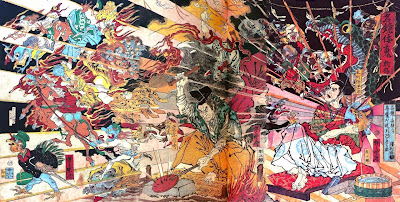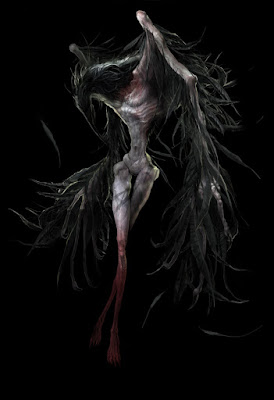Twin creatures of mysterious nature and sumptuous dress sell strange wares beneath a red silk canopy on the side of the road.
- Arre has the grinning head of a coyote, tongue lolling, eyes a dull red. She is polite, accommodating, and will not insist on anything but a price. She sells magic-user and cleric scrolls (all spells with a level of 6 or higher). She does not take money, but requires a live captive with HD double the level of the scroll’s spell.She fights as a gargoyle (AC 5 HD 4 MV 90 ATK 2 claws/1 bite/1 horn DMG 1d3/1d3/1d6/1d4 ST Fighter 8 ML 11 TT C AL C, Immune to non-magical weapons)
- Erre has the head of a monkey, expression neutral, eyes a lambent red. He is profane, deceitful, and delights in insult. He sells magic items (three random magic items in stock, changes out each midnight). He accepts only ancient coinage, and each item costs 500+d1000 gp. He fights as a wraith (AC 3 HD 4 MV 120′ (FLY 240′) ATK 1 DMG 1d6+Energy Drain ST Fighter 4 ML 11 TT E AL C, Immune to non-silver and non-magical weapons)
II
A small and unpleasant village. The well has been spoiled recently and a spirit haunts the village chief, a man called Nazario.
- The well was spoiled by the brother of Nazario’s dead wife, who wants to be chief and is sabotaging Nazario’s rule.
- Nazario is haunted by the spirit Búho because he murdered his wife, the daughter of the last chief, five years ago. He rules the village benevolently, but will kill again to maintain his secret.
- The villagers blame the haunting and the spoiled well on the nearby encampment of half-djinn. They would have driven away or killed them by now if not for the efforts of the village chief.
III
An encampment of half-djinn outcasts. They have thus far maintained a measure of peace and prosperity through the power and guidance of the great djinni Al-Ra’ad al-Kasif, but he has been missing for over a month.
- A band of slavers has been kidnapping djinni across the Isle. The leader of the encampment, Fátima, wants the slavers killed and her fellows freed.
- Shams, the great-grandson of al-Kasif, maintains his ancestor’s house, buried beneath the encampment. It contains immense wealth, but its guardians are vigilant and powerful.
- Befriending the encampment allows players to create half-djinn characters.
- The half-djinn fight as elves (AC 5 HD 1+1 MV 120’ ATK 1 DMG 1d8 ST Elf 1 ML 8 TT E AL Neutral, Know a random 1st level magic-user spell)
IV
A decaying monastery occupied by a society of necromancers. A small shantytown has sprung up around the monastery’s walls, full of indentured servants paying off the necromancer’s services.
- The necromancers can raise any human from the dead, as long as a corpse and their true name is provided. The dead raised this way have the mental attributes, knowledge, and abilities they had in life, but the physical characteristics of their new body. This service costs a number of gold pieces equal to the experience total of the one to be resurrected. Anyone raised this way cannot gain XP.
- The indentured servants despise the necromancers for their abuse and cupidity, but each is desperate to bring someone back to life.
- The necromancers know the secret of summoning Las Muertas, but will not teach it to anyone outside of their ranks. A summoner must enroll in the society or else just steal the ritual.
V
A band of hunters makes their camp here, hidden inside a thicket. Several of their children have gone missing, and in the weeks since their search started, something has begun to mutilate the horses.
- The children have been stolen by the spirit Angroda, who maintains her lair in the bole of an immense black tree in the same hex as the camp.
- The horse-killer is one of the hunters, cursed with lycanthropy. He killed an ancient jaguar while searching for the missing children, and it bit him as it died. He is too frightened to set off on his own and even more afraid of being killed by his friends and family, so he has been satisfying his new hunger with the band’s horses. He fights as a weretiger (AC 3 HD 5 MV 150’ ATK 2 claws/1 bite DMG 1d6/1d6/2d6 ST Fighter 5 ML 9 TT C AL N, Immune to non-magical or non-silver weapons, can summon 1d2 jaguars 1/day)
VI
An abandoned hacienda. Withered cattle, untouched by insects, lay dead in locked barns, and the silos are filled with rotted grain. In the manor, the two dozen bodies hang from the rafters.
- The hanged were once the hacienda’s household. In life, they sacrificed humans to an Old God in return for bountiful crops. When the Saint-king sent an agent to investigate the disappearances, they killed themselves when discovery seemed inevitable.
- The dead are restless in this house. The bodies will reanimate and attempt to kill anyone who enters the manor. They will do their best to keep anyone from entering the basement, where they kept the remains of their victims.
- The basement contains the remains of the sacrificial victims, as well as the body of the Saint-king’s agent. Unbeknownst to the murderers, he tripped down the stairs and broke his neck while investigating. He is an immobile skeleton, but is quite friendly and rather voluble.
- The murderers fight as wights (AC 5 HD 3 MV 90 ATK 1 DMG Energy Drain ST Fighter 3 ML 12 TT B AL C, Immune to non-silver and non-magical weapons). As long as they are still tied to a rafter and nothing living can see them or their destination, they can teleport to any other rafter in the house. If cut from the roof, they cannot teleport, but can move freely.







